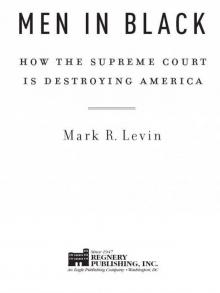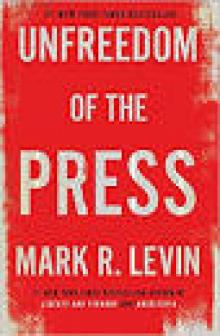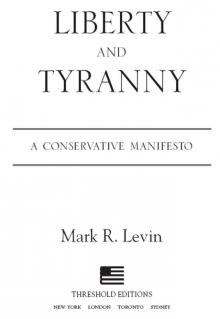- Home
- Mark R. Levin
Plunder and Deceit: Big Government's Exploitation of Young People and the Future Page 12
Plunder and Deceit: Big Government's Exploitation of Young People and the Future Read online
Page 12
The Islamic regime in Iran is developing capabilities to strike American forces in the Persian Gulf.22 More than 90 percent of Persian Gulf oil passes through the Strait of Hormuz, which borders Iran and is only twenty-one miles wide through its narrowest stretch.23 Iran has significant mine-laying capabilities that threaten commercial and military vessels.24 Iran also has a fleet of small but effective submarines, attack boats, and coastal missile batteries that can reach Israel.25 Moreover, the 2013 Worldwide Threat Assessment of the United States Intelligence Community, released on January 24, 2014, warns that “Tehran has made technical progress in a number of areas—including uranium enrichment, nuclear reactors, and ballistic missiles—from which it could draw if it decided to build missile-deliverable nuclear weapons. These technical advancements strengthen our assessment that Iran has the scientific, technical, and industrial capacity to eventually produce nuclear weapons.”26 Director of National Intelligence James R. Clapper’s assessment also cautions that “Iran would choose a ballistic missile as its preferred method of delivering nuclear weapons. Iran’s ballistic missiles are inherently capable of delivering WMD, and Iran already has the largest inventory of ballistic missiles in the Middle East. Iran’s progress on space launched vehicles—along with its desire to deter the United States and its allies—provides Iran with the means and motivation to develop longer range missiles, including intercontinental ballistic missiles (ICBM).”27
Incredibly, in the most recent Worldwide Threat Assessment of the U.S. Intelligence Community, released on February 26, 2015, for political reasons the Obama administration downplayed Iran’s national security threat and does not even mention Iran in the section on terrorism, essentially whitewashing Iran’s significantly increased territorial gains and military advances.28 However, Iran’s designs on the Middle East and beyond are vast and growing. It is building “an arc of power” or “Shia crescent” stretching from Lebanon to Syria, Iraq to Yemen, and throughout other countries and territories by funding and arming terrorist surrogates.29
Respecting North Korea, the 2013 Worldwide Threat Assessment of the U.S. Intelligence Community report is alarming. It provides, in part, that “North Korea’s nuclear weapons and missile programs pose a serious threat to the United States and to the security environment in East Asia, a region with some of the world’s largest populations, militaries, and economies. North Korea’s export of ballistic missiles to and associated materials to several countries, including Iran and Syria . . . illustrate the reach of its proliferation activities.”30 Indeed, as the Wall Street Journal recently reported, even the “latest Chinese estimates, relayed in a closed-door meeting with U.S. nuclear specialists, showed that North Korea may already have 20 warheads, as well as the capability of producing enough weapons-grade uranium to double its arsenal by next year, according to people briefed on the matter.”31
More broadly, the 2013 Threat Assessment declares that “Nation-state efforts to develop or acquire weapons of mass destruction (WMD) and their delivery systems constitute a major threat to the security of our nation, deployed troops, and allies. The Intelligence Community is focused on the threat and destabilizing effects of nuclear proliferation, proliferation of chemical and biological warfare (CBW)-related materials, and development of WMD delivery systems.”32
But over the last several decades, another kind of grave threat has emerged. In January 1987, the National Security Strategy of the United States declared, “An additional threat, which is particularly insidious in nature and growing in scope, is international terrorism—a worldwide phenomenon that is becoming increasingly frequent, indiscriminate, and state-sponsored.”33
Beyond its military threat, Iran (in partnership with the Hezbollah terrorist organization) and other countries, such as Syria, Yemen, Lebanon, Libya, Tunisia, Afghanistan, Pakistan, Kazakhstan, Somalia, and others, sponsor, tolerate, or ineffectively oppose terrorist organizations training or operating within their borders.34 Moreover, vast areas of the Middle East, Arabian Peninsula, and Sub-Saharan Africa are in turmoil.35 And terrorist groups are taking advantage of the opportunities to fill the resulting power vacuum.36
In addition to state actors, there are the well-organized and well-financed terrorist organizations conquering vast land areas, where they are perpetrating heinous acts of inhumanity. Two of the most obvious examples are al-Qaeda and the Islamic State. They are dedicated to forming a “caliphate”—an Islamic government said to be led by the political and religious successor to the prophet Muhammad. Both are dedicated to the destruction of Western civilization. The national security implications for the United States and allies such as Israel, Egypt, Jordan, and Saudi Arabia, among others, are extremely dangerous.37
Al-Qaeda’s stated goals are to “establish the rule of God on earth; attain martyrdom in the cause of God; and purification of the ranks of Islam from the elements of depravity.”38 The Islamic State seeks to establish the caliphate in Persia, first by taking over Iran in order to obtain Iran’s nuclear weapons.39
The genocidal methods and aims of these terrorist groups cannot be overstated. The Islamic State urges the use of biological weapons on “unbelievers.” A “fatwa” issued by an Islamic State cleric declares that “If Muslims cannot defeat the kafir [unbelievers] in a different way, it is permissible to use weapons of mass destruction.”40 Found on a laptop computer recovered from an Islamic State stronghold, the fatwa went on to justify the use weapons of mass destruction “[e]ven if it kills all of [the unbelievers] and wipes them and their descendants off the face of the earth.”41 Biological weapons are favored for terrorist use because they do not cost much money and can cause “huge” human casualties.42 In a “how to” document also found on the Islamic State laptop, jihadists are encouraged to “use small grenades loaded with viruses” such as bubonic plague and to “throw them in closed areas like metros, soccer stadiums, or entertainment centers. But to do it next to the air conditioning.”43 Of course, these bombs “can also be used during suicide operations.”44
The large-scale war crimes, crimes against humanity, and genocide perpetrated by the Islamic State terrorists and other jihadist groups remind the world daily of their calamitous threat to civilization and mankind.45
But terrorists are not living and training only in faraway Third World countries. Attacks have occurred in Paris, London, Madrid, and Jerusalem, and, obviously, in New York, Washington, and the skies above the United States on September 11, 2001, when nineteen al-Qaeda terrorists murdered thousands of Americans. It is also a virtual certainty that terrorist “sleeper cells” are secreted in America. In 2009, former director of national intelligence Dennis C. Blair warned Congress that terrorist organizations, including al-Qaeda and the Islamic State, are known to be working to radicalize Muslims in America.46 Iran and Hezbollah have a strong recruiting presence in the United States, Mexico, and throughout Latin America.47 Former Obama administration attorney general Eric Holder and California senator Dianne Feinstein, ranking Democrat on the Senate Intelligence Committee, acknowledged as much following the slaughter of writers and cartoonists at a Paris magazine office.48 New America Foundation senior fellow Robert Wright explained that homegrown terrorists are an immediate concern, having already struck in the United States, for example, in the Fort Hood mass murder, which killed thirteen people, and the Boston Marathon bombing, which killed three and wounded more than 250.49
In February 2015, the same day federal authorities in New York charged three Muslim immigrants with conspiracy to provide material support to the Islamic State, FBI director James Comey told a meeting of state attorneys general: “I have home-grown violent extremist [domestic terrorist] investigations in every single state.”50 In April 2015, the United States attorney for Minnesota, Andrew Luger, announced that six Somali-American men from Minnesota, all naturalized American citizens, were charged with planning to join the Islamic State and that they were part of a larger conspiracy that included friends and relatives. He further declar
ed: “We have a terror recruiting problem in Minnesota.”51
A recent Pew Research Center analysis further underscores the seriousness of the problem.52 The results of Pew’s research discloses that while the vast majority of American Muslims oppose terrorist organizations and tactics, there are still a distressing number who support the use of terror tactics against civilians.53
Respondents were asked whether they believed that “suicide bombing or other forms of violence against civilian targets are justified to defend Islam from its enemies.” While 81 percent oppose such tactics under any circumstances, 8 percent say these tactics are often or sometimes justified.54 Another 5 percent responded that the use of violence against civilians might be justified in rare circumstances.55 As there are 1.8 million adult American Muslims in the United States, this suggests that at least theoretically as many as thirteen thousand support the use of suicide bombs or other forms of terrorism. The survey also showed that native-born Muslims—in particular African-American Muslims—are more likely to support the use of violence.56
Pew reports that a “significant minority (21 percent) of Muslim Americans say that there is a great deal (6 percent) or a fair amount (15 percent) of support for extremism in the Muslim American community” and it is on the rise.57 Furthermore, nearly half of American Muslims say that Muslim leaders in the United States are not doing enough to speak out against Islamic extremism.58
There are also significant technological threats to the nation’s interests in space and cyberspace, which target nearly every American, the economy, and the country’s security. For example, satellites have revolutionized communication throughout the world.59 They are now critical to both commercial and military interests.60 But satellites are vulnerable to destruction in two distinct ways—accidental collision and intentional interference or destruction.61 China, Brazil, Iran, Iraq, and Turkey all have interfered with American satellite operations at one time or another in recent years.62 China and Russia both have extensive space programs and are capable of significantly disrupting satellite security.63
The federal government, the military in particular, is dependent on the Internet and digital networks, making network infrastructure and security a significant vulnerability.64 The Department of Defense (DOD) alone uses fifteen thousand networks and has 7 million computing devices in service, which has led the DOD to “formally recognize cyberspace for what it is—a domain similar to land, sea, air and space,” according to former deputy secretary of defense William Lynn.65 Lynn also noted that more than one hundred foreign intelligence agencies have tried to access American networks.66
According to a Pew Research Center study, 61 percent of cybersecurity experts believe that there will be a major cyberattack by 2025, which could result in severe economic losses and potentially significant loss of life.67 The experts surveyed raised concerns about the vulnerability of the nation’s financial system, power grid, air traffic control system, health-care system, and many other critical aspects of American society.68
In the meantime, Chinese hackers recently launched a massive attack on federal government databases, stealing personnel information and security clearance details on millions of federal workers, which cybersecurity experts believe could be used in future attacks against the United States.69 70
In the 2014 Quadrennial Defense Review (QDR), the DOD presented its long-range assessment of United States military readiness and plans for the future. By statute, the National Defense Panel (NDP), a nonpartisan ten-member body appointed by Congress, is required to review the QDR’s adequacy. The panel concluded that under the Obama administration’s military plan “there is a growing gap between the strategic objectives the U.S. military is expected to achieve and the resources required to do so.”71 The significant funding shortfall is “disturbing if not dangerous in light of the fact that global threats and challenges are rising, including a troubling pattern of territorial assertiveness and regional intimidation on China’s part, the recent aggression of Russia in Ukraine, nuclear proliferation on the part of North Korea and Iran, a serious insurgency in Iraq that both reflects and fuels the broader sectarian conflicts in the region, the civil war in Syria, and civil strife in the larger Middle East and throughout Africa.”72
For example, while China expects to have 350 ships by 2020, the NDP report notes that the Obama administration provides for only 260 ships or fewer, which is far less than the 323 to 326 required to meet the potential challenges in the Western Pacific.73 And despite increasing threats worldwide, the Obama strategy calls for the smallest and oldest air force fleet in modern history, planning a 50 percent reduction to bomber, fighter, and surveillance forces by 2019.74 The NDP concludes that the Obama defense budget “will increasingly jeopardize our international defense posture and ultimately damage our security, prospects for economic growth, and other interests.”75
Despite the mounting and diverse national security threats facing the nation, a study conducted by Brookings Institute defense strategist P. W. Singer and his colleagues finds that a majority of younger people consider the United States the world’s provocateur. Fifty-seven percent of younger people born between 1980 and 2005 believe America is too involved in global affairs (60 percent of younger Democrats and 50 percent of the group’s Republicans share this view).76 Sixty-six percent of younger people believe that reliance on military force creates hatred toward the United States that, in turn, fosters more terrorism.77
The Pew Center for the People and the Press reports a “stark difference across generational lines in how people look back at America’s actions prior to the [9/11] attacks. Younger Americans are far more likely to say that there are things the U.S. did wrong in its dealings with other countries that might have motivated the Sept. 11 attacks.”78 In sharp contrast to the governing generation, Pew’s polling found that 53 percent of younger people born between 1981 and 2005 believe the United States acted in ways that may have motivated the terrorist attacks.
As the nation has learned time and again, it is American military preparedness and superiority, in combination with a proactive and prudent foreign policy, that are likely to serve as a deterrent to military conflict and prevent large-scale, long-lasting wars. Should war occur—and at times war is unavoidable—the United States must ensure that its young service personnel are the best trained and equipped on the face of the earth. Yet at precisely the time in American history when younger people need to be most vigilant and vocal, given the multiple and rising dangers facing the nation and, sadly, the failure of public officials to adequately prepare for these threats, Pew reports that more than 65 percent of younger people born between 1981 and 2005 support reducing military spending in order to preserve spending on social programs.79
Again, it is younger people who are called upon to defend America, American interests, and America’s allies against serious and looming national security and military dangers. The DOD “2013 Demographics: Profile of the Military Community” reports that more than one-quarter (25.8 percent) of active duty officers are 41 years of age or older; however, the next-largest age group is 26 to 30 years (22.7 percent), followed by 31 to 35 years (20.4 percent), 36 to 40 years (18.0 percent), and those 25 years or younger (13.2 percent). Even more, nearly one-half (49.4 percent) of active duty enlisted personnel are 25 years of age or younger, with the next-largest age group 26 to 30 years (22.5 percent), followed by 31 to 35 years (13.7 percent), 36 to 40 years (8.8 percent), and those 41 years or older (5.5 percent). Overall, therefore, the average age of the active duty force is 28.6 years. The average age for active duty officers is 34.8 years. And the average age for active duty enlisted personnel is 27.3 years.80 Should the nation’s interests or even survival become so imperiled as to require a draft, it will be younger people who are called upon to take up arms.
On July 17, 1980, in his speech accepting the Republican nomination for president, Ronald Reagan said, in part: “We are not a warlike people. Quite the opposite. We always seek to live i
n peace. We resort to force infrequently and with great reluctance—and only after we have determined that it is absolutely necessary. We are awed—and rightly so—by the forces of destruction at loose in the world in this nuclear era. But neither can we be naive or foolish. Four times in my lifetime America has gone to war, bleeding the lives of its young men into the sands of beachheads, the fields of Europe, and the jungles and rice paddies of Asia. We know only too well that war comes not when the forces of freedom are strong, but when they are weak. It is then that tyrants are tempted. We simply cannot learn these lessons the hard way again without risking our destruction.”81
TEN
* * *
ON THE CONSTITUTION
WHY SHOULD THE UNITED States Constitution, and the faithful adherence to and execution of it by public officials, matter to younger people? It provides the governing order of a republic intended to protect the individual’s liberty from a tyrannical centralized authority and, conversely, the anarchy of mob rule.
On September 17, 1787, at the conclusion of the Constitutional Convention in Philadelphia, delegate James Wilson, on behalf of the ailing Benjamin Franklin, read aloud Franklin’s speech to the convention in favor of adopting the Constitution. Franklin stated, in part: “I agree to this Constitution, with all its Faults, if they are such: because I think a General Government necessary for us, and there is no Form of Government but what may be a Blessing to the People if well administered; and I believe farther that this is likely to be well administered for a Course of Years, and can only end in Despotism as other Forms have done before it, when the People shall become so corrupted as to need Despotic Government, being incapable of any other.”1

 The Liberty Amendments: Restoring the American Republic
The Liberty Amendments: Restoring the American Republic Rediscovering Americanism: And the Tyranny of Progressivism
Rediscovering Americanism: And the Tyranny of Progressivism Plunder and Deceit: Big Government's Exploitation of Young People and the Future
Plunder and Deceit: Big Government's Exploitation of Young People and the Future Men in Black: How Judges Are Destroying America
Men in Black: How Judges Are Destroying America Unfreedom of the Press
Unfreedom of the Press Ameritopia: The Unmaking of America
Ameritopia: The Unmaking of America Liberty and Tyranny
Liberty and Tyranny Rediscovering Americanism
Rediscovering Americanism Ameritopia
Ameritopia Plunder and Deceit
Plunder and Deceit